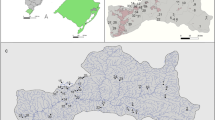Abstract
This study evaluated and compared the occurrence, concentrations, and genetic diversity of bovine polyomavirus (BPyV) and bovine adenovirus (BAdV) in manure and feces samples for the purpose of determining which of these two viruses is more suitable for bovine fecal indication and microbial source tracking. The comparability and correlation between concentrations/prevalence of these viruses and bacterial fecal indicators (cow-associated Bacteroidetes, Escherichia coli and enterococci) in manure and fecal samples was also determined. A total of 26 dairy manure and 18 individual dairy cow feces samples were tested. The results showed the mean concentration of BAdV in all of dairy manure samples was at least 1 log lower than BPyV (p ≤ 0.005). All of the dairy manure samples tested positive for BPyV but not for BAdV. After combining dairy manure measurements, bacterial indicators had 0.3–0.7 log (p ≤ 0.05) and 1.8–2.2 log (p ≤ 0.005) higher concentrations than BPyV and BAdV, respectively. The concentration of BPyV had a significant positive correlation with the concentration of E. coli and enterococci in the manure samples. The partial VP1 genetic sequences of BPyV isolated from three different farms had a 100% homology to each other and to VP1 sequence (D13942.1) reported in previous study. Based on the occurrence, quantitative and genetic diversity results, BPyV may be a better indicator than BAdV for microbial source tracking at manure application sites.


Similar content being viewed by others
References
Bofill-Mas S, Formiga-Cruz M, Clemente-Casares P, Calafell F, Girones R (2001) Potential transmission of human polyomaviruses through the gastrointestinal tract after exposure to virions or viral DNA. J Virol 75:10290–10299
Bofill-Mas S, Albinana-Gimenez N, Clemente-Casares P, Hundesa A, Rodriguez-Manzano J, Allard A, Calvo M, Girones R (2006) Quantification and stability of human adenoviruses and polyomavirus JCPyV in wastewater matrices. Appl Environ Microbiol 72:7894–7896
Chen YC, Higgins MJ, Maas NA, Murthy SN (2006) DNA extraction and Escherichia coli quantification of anaerobically digested biosolids using the competitive touchdown PCR method. Water Res 40:3037–3044
de Motes CM, Clemente-Casares P, Hundesa A, Martin M, Girones R (2004) Detection of bovine and porcine adenoviruses for tracing the source of fecal contamination. Appl Environ Microbiol 70:1448–1454
Echavarria M, Forman M, Ticehurst J, Dumler JS, Charache P (1998) PCR method for detection of adenovirus in urine of healthy and human immunodeficiency virus-infected individuals. J Clin Microbiol 36:3323–3326
Haugland RA, Siefring SC, Wymer LJ, Brenner KP, Dufour AP (2005) Comparison of Enterococcus measurements in freshwater at two recreational beaches by quantitative polymerase chain reaction and membrane filter culture analysis. Water Res 39:559–568
Henderson YC, Liu TJ, Clayman GL (1998) A simple and sensitive method for detecting adenovirus in serum and urine. J Virol Meth 71:51–56
Hundesa A, de Motes CM, Bofill-Mas S, Albinana-Gimenez N, Girones R (2006) Identification of human and animal adenoviruses and polyomaviruses for determination of sources of fecal contamination in the environment. Appl Environ Microbiol 72:7886–7893
Hundesa A, Bofill-Mas S, Maluquer de Motes C, Rodriguez-Manzano J, Bach A, Casas M, Girones R (2010) Development of a quantitative PCR assay for the quantitation of bovine polyomavirus as a microbial source-tracking tool. J Virol Meth 163:385–389
Layton A, McKay L, Williams D, Garrett V, Gentry R, Sayler G (2006) Development of Bacteroides 16S rRNA gene TaqMan-based real-time PCR assays for estimation of total, human, and bovine fecal pollution in water. Appl Environ Microbiol 72:4214–4224
Lee DY, Weir SC, Lee H, Trevors JT (2010) Quantitative identification of fecal water pollution sources by TaqMan real-time PCR assays using Bacteroidales 16S rRNA genetic markers. Appl Microbiol Biotechnol 88:1373–1383
Okabe S, Okayama N, Savichtcheva O, Ito T (2007) Quantification of host-specific Bacteroides-Prevotella 16S rRNA genetic markers for assessment of fecal pollution in freshwater. Appl Microbiol Biotechnol 74:890–901
Schuurman R, Sol C, Vandernoordaa J (1990) The complete nucleotide sequence of bovine polyomavirus. J Gen Virol 71:1723–1735
Scott TM, Rose JB, Jenkins TM, Farrah SR, Lukasik J (2002) Microbial source tracking: current methodology and future directions. Appl Environ Microbiol 68:5796–5803
Sibley SD (2011) Concentration and molecular detection of bovine adenoviruses for fecal source tracking. University of Wisconsin at Madison, Madison, p 150
USEPA (2010) Method A: Enterococci in Water by TaqMan® Quantitative Polymerase Chain Reaction (qPCR) Assay. EPA-821-R-10-004. U.S. Environmental Protection Agency, Washington, DC
Wong K, Xagoraraki I (2010) Quantitative PCR assays to survey the bovine adenovirus levels in environmental samples. J Appl Microbiol 109:605–612
Wong K, Xagoraraki I, Wallace J, Bickert W, Srinivasan S, Rose JB (2009) Removal of viruses and indicators by anaerobic membrane bioreactor treating animal waste. J Environ Qual 38:1694–1699
Yates MV (2007) Classical indicators in the 21st century—far and beyond the coliform. Water Environ Res 79:279–286
Acknowledgment
The authors would like to acknowledge Brandon Onan for assisting with sample analysis and Rebecca Ives for proofreading this manuscript.
Author information
Authors and Affiliations
Corresponding author
Rights and permissions
About this article
Cite this article
Wong, K., Xagoraraki, I. Evaluating the prevalence and genetic diversity of adenovirus and polyomavirus in bovine waste for microbial source tracking. Appl Microbiol Biotechnol 90, 1521–1526 (2011). https://doi.org/10.1007/s00253-011-3156-z
Received:
Revised:
Accepted:
Published:
Issue Date:
DOI: https://doi.org/10.1007/s00253-011-3156-z




